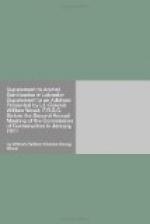on the hill-sides, on the most distant and northern
islands—as far north as any of our
explorers have gone. The first birds Sverdrup
met as he was coming south, in the early spring, were
wild geese. These birds are not disturbed on their
breeding grounds. The Eskimo do not meddle
with them. In the same way caribou are found
feeding about the shores of Hudson bay and strait.
Like the geese, they feed on berries about the
hill sides. I have shot them at the mouth of
Churchill river, and near cape Digges in August,
when they were very fat—so fat that
it is said that, on falling on hard ground, they
would burst open; though this did not actually
happen in my case. I certainly think that it would
be a grand thing to have certain groups of islands—or
even certain sections of coast—set
apart as bird sanctuaries.
Your paper deals entirely with conditions in Labrador. There is, however, another part of the Gulf coast, where the need of protection is much greater than on the Labrador. That is the interior of the Gaspe peninsula. A certain region in the interior has been set aside as a park, but it is quite unprotected. Here, we have moose, woodland caribou and the red deer, besides nearly all the fur-bearing animals that we find on the Labrador. There is no game protection whatever. Moose and caribou are killed mostly out of season—when they are yarded, or when it is easy to run them down. In many cases the meat is left in the woods, the hide only being wanted. Lumbermen are penetrating up the rivers, further into the interior—every lumber camp is a centre from which the game laws are persistently violated.... the game, both fur and feather, (particularly the ruffled grouse) is rapidly disappearing before their pitiless onslaughts. Lumber camps are opened much earlier in the season than they used to be; so that the interior lakes and head waters of the rivers are being cleaned out of fish taken while in the act of spawning. All this may seem very strong language; but it is really not exaggerated. It may help to show the need of more and better conservation....
Mr. Alfred Russell Wallace, the founder and exponent of the science of zoo-geography, writes:
... your address on “Animal Sanctuaries” in Labrador, which I have read with the greatest interest and astonishment. Such reckless destruction I should hardly have thought possible.
There is a considerable public opinion now against the use of feathers as ornaments[A] because it inevitably leads to the extermination of some of the most beautiful of living things; but I think the attempts to stop it by legal enactments begin at the wrong end. They seek to punish the actual collectors or importers of the plumes, who are really the least guilty and the most difficult to get at. It is the actual wearers of such ornaments who should be subject to fines or even imprisonment, because, without the demand




